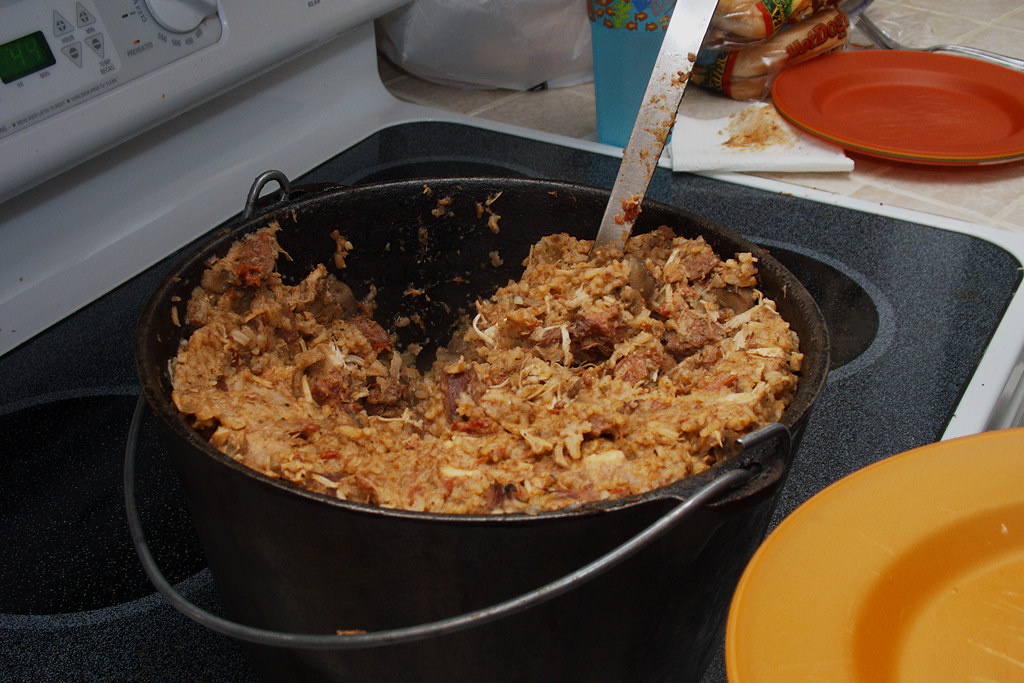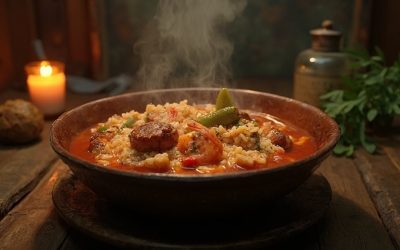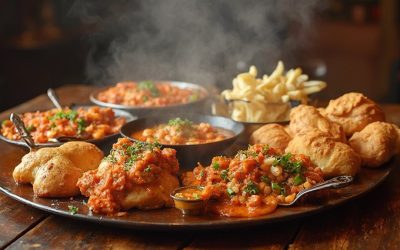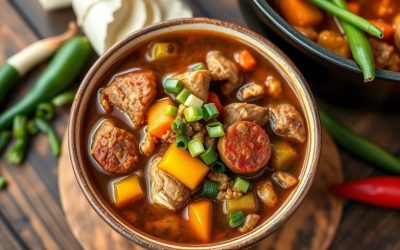You’ll discover authentic Cajun cuisine’s rich heritage in Louisiana’s vibrant food culture, where traditional French cooking meets Gulf Coast ingredients. The famous “holy trinity” of onions, celery, and bell peppers forms the foundation of classic dishes like gumbo, jambalaya, and étouffée. You can taste the influence of Acadian settlers who adapted their recipes using local seafood, rice, and distinctive spices. From communal crawfish boils to festive Mardi Gras celebrations, Cajun food brings people together through time-honored cooking methods and shared meals. The deeper you explore this unique culinary tradition, the more flavors and stories you’ll uncover.
Origins of Cajun Cooking
From the shores of Maritime Canada to the bayous of Louisiana, Cajun cuisine’s journey commenced with the forced exodus of French Acadian settlers in 1755. Known as Le Grand Dérangement, this Acadian migration saw over 14,000 displaced French colonists making their way to Southwest Louisiana, where they’d create one of America’s most distinctive culinary traditions.
You’ll find that these resilient settlers, whose name evolved from “Les Acadiens” to “Cajun,” didn’t simply transplant their existing cuisine. Instead, they initiated a remarkable culinary adaptation, transforming their traditional peasant-style cooking to embrace their new environment. They replaced their familiar seafood – lobster, cod, and salmon – with Louisiana’s abundant Gulf treasures like crawfish, shrimp, and oysters. You’ll notice how they swapped potatoes for rice, which thrived in Louisiana’s humid climate and incorporated local vegetables and wild game into their cooking.
Their interactions with Native Americans, West Africans, and other European settlers enriched their culinary repertoire. They learned to use exotic spices like cayenne pepper and adopted cooking techniques from enslaved people from the West Indies, creating the vibrant, flavorful cuisine you know today.
Essential Cajun Kitchen Tools
In the heart of every Cajun kitchen, you’ll find an arsenal of specialized tools that make traditional Louisiana cooking possible. Large stock pots and jambalaya combos form the foundation for cooking essential ingredients like gumbo, crawfish, and fried turkey. You’ll need sturdy stainless steel roux pots to perfect your cooking techniques when preparing the all-important roux base.
For authentic Cajun cooking, you’ll want to equip yourself with Bayou Classic stir paddles and skimmers. These tools are vital when handling seafood and stirring large batches of jambalaya. The Toadfish collection, including the crab mallet, folding filet knife, and shrimp cleaner, makes seafood preparation efficient and precise.
The Boil Boss paddle and specialized seafood tool sets help you manage large-scale cooking operations, while disposable crawfish platters make serving simple. Don’t forget practical accessories like the stainless steel measure conversion magnet for recipe accuracy and the ground meat chopper for preparing proteins. These tools aren’t just equipment – they’re essential elements that help preserve and perfect traditional Cajun cooking techniques.
The Famous Holy Trinity
At the foundation of every authentic Cajun dish lies the Holy Trinity – a sacred combination of diced onions, green bell peppers, and celery. This flavor enhancement base, popularized by Chef Paul Prudhomme in the late 1970s, adapts the French mirepoix by substituting bell peppers for carrots, reflecting Louisiana’s unique culinary heritage.
You’ll typically use a 2:1:1 ratio of onions to celery and bell peppers, though some cooks prefer equal portions of each. When you’re preparing gumbo, jambalaya, étouffée, or red beans and rice, you’ll want to dice these vegetables and sauté them until the onions become translucent and release their aromatic qualities. For an extra depth of flavor, you can add garlic – a variation that’s playfully known as “the pope.”
The Holy Trinity earned its name from the Christian doctrine, and you’ll find it’s essential in both Cajun and Creole cooking traditions. Whether you’re making stocks, sauces, soups, or stews, this vegetable base creates the distinctive flavors that define Louisiana cuisine. You’ll often cook it in oil or fat before incorporating it into a roux, laying the groundwork for countless classic dishes.
Classic Cajun Family Recipes
Passed down through generations of Louisiana families, classic Cajun recipes tell stories of resourcefulness, tradition, and bold flavors. You’ll find these heirloom recipes at the heart of every Cajun kitchen, where dishes like jambalaya and gumbo showcase the region’s love for well-seasoned, hearty meals.
For your main course, you can’t go wrong with étouffée, a rich seafood stew that perfectly balances Cajun spices with tender shrimp or crawfish. The legendary crawfish boil brings families together, while boudin offers a portable taste of Louisiana’s culinary heritage. Traditional sides like dirty rice and corn maque choux complement these dishes beautifully, adding layers of flavor to your meal.
When it’s time for something sweet, you’ll want to try beignets, those irresistible powdered sugar-dusted pastries that New Orleans made famous. For special occasions, you can elevate your menu with a Cajun deep-fried turkey or host a cochon de lait, where slow-cooked pork becomes the centerpiece of celebration. Don’t forget to round out your feast with classic sides like smothered green beans and potatoes, all seasoned with generations of Cajun cooking wisdom.
Community Traditions and Food
Cajun community spirit comes alive through vibrant food-centered celebrations that weave together music, faith, and centuries-old traditions. You’ll find this spirit on full display during Cajun Mardi Gras, where masked horsemen chase chickens through towns like Church Point and Mamou, gathering ingredients for a communal gumbo that brings everyone together.
In these communal gatherings, you’ll experience the heart of Cajun culture every weekend, while families unite for cooking, music, and dancing. At venues like the Blue Moon Saloon and Fred’s Lounge, you can join traditional fais do-do dance parties where accordion and fiddle music fill the air. The celebrations often center around iconic dishes like gumbo, seasoned with filé and made with rich, flavorful stock.
Religious traditions blend seamlessly with these festivities. You’ll spot yard grottoes with Virgin Mary statues throughout neighborhoods, and during the Fête Dieu du Teche, you can witness boats processing down the bayou, honoring Acadian Catholic heritage. Whether you’re sharing a pot of jambalaya at Rita Mae’s Kitchen or dancing at the Jolly Inn, you’re participating in traditions that have sustained Cajun community life for generations.
Conclusion
You’ll find that Cajun cuisine is more than just spicy food – it’s a reflection of Louisiana’s resilient spirit and rich heritage. Whether you’re stirring a dark roux, chopping the holy trinity, or gathering for a crawfish boil, you’re participating in traditions passed down through generations. Keep these authentic flavors alive in your kitchen, and you’ll always have a taste of Louisiana’s warm hospitality and vibrant culture.



